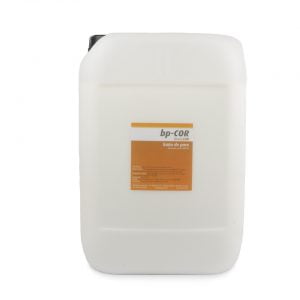22,00€ – 850,00€
Like the act-COR liquid product, this gel version is used to oxidise iron and corten steel surfaces. It is green in colour with a highly viscous texture, hence the reason why it gives better control during its application. It is especially recommended for use on vertical surfaces, ceilings and hard-to-reach places.
The product can also be useful for achieving “over-oxidation” and creating detail on the surface because by adding additional quantities of the product, it causes it to agglutinate, taking longer to dry. The gel can be spread on the surface using a spatula, roller or brush (whichever you prefer) and thereby a greater “modelling” of the effects of the oxidation can be achieved, making it much more manageable if you want to create irregular finishes. It also has the ability to “re-oxidize” a surface that has already been oxidized for a long time, bringing back a lighter tone. With act-COR Gel, you can achieve a controlled, orange-coloured oxidation (initial colour of oxidation) that is usually very difficult to achieve, even with liquid act-COR, due to different factors such as humidity, MILL SCALE, thickness of the sheet, and so on.
Another characteristic of this product is that the oxidation results in a lot less oxide dust being produced when compared to it being treated with liquid act-COR, allowing it to be sealed with bp-COR; and even when it is left unsealed, the resulting oxide dust will still be a lot less.
VERY IMPORTANT: This product has a working and storage temperature range of between 10 and 25ºC. Outside of this range, its physical characteristic changes to a liquid state.
Please read the product’s Technical Data Sheet and Safety Data Sheet carefully, to ensure understanding of how the product needs to be applied and to comply with relevant safety and environmental regulations.
FREQUENTLY ASKED QUESTIONS
You will achieve a faster oxidation, have more control over the oxidation process and achieve an orangey colour (like a primary oxidation). It can be applied on surfaces that are difficult-to-access, as well as on vertical surfaces.
No, it is a weak activator like the liquid version, but where the sheet thickness is 1 mm or less and the steel has been cold-rolled, it is better to monitor and control the process.
Yes, no problem.
No, although it is advisable to use rubber gloves (latex), goggles, etc. at all times. And please always read the product’s Safety Data Sheet (SDS) and Technical Data Sheet (TDS) before starting to use it.
No, the function of this product is to activate the oxidation. There is a product in a gel format (dx-COR Gel) that has the ability to extract MILL SCALE.
It is recommended to carry out the work when the ambient temperature is between 10° C and 30° C. Outside of this temperature range, the product will crystallize (below 10º C) or liquefy (above 30º C), and the results achieved will be very different to those you were expecting.
In addition to facilitating applications in areas that are difficult-to-access or on sheets in a vertical position, act-COR Gel is able to oxidize corten steel in a very special way. This is because it can be applied using a trowel and by doing so, different thicknesses can be achieved on the sheet you are treating. It can lighten a dark oxide from years ago, making it brighter and more natural. We do recommend that you practice first though on part of the sheet before executing the final project.
On vertical surfaces or on steel sheets that have already been installed and where the use of a liquid product is not possible
Yes, if the sheet has not been sand-blasted or properly stripped (of mill scale), then the oxidation will be very uneven.
Yes, it is highly recommended. Oxidization with b-COR metal base is much better when used in conjunction with the act-COR Gel activator.







